HP dm1z: Taking Fusion on the Road
by Dustin Sklavos on February 21, 2011 7:00 PM ESTFusion-Powered: Application and Futuremark Performance
This was my first experience with AMD's E-350 APU, a chip which has been the subject of some contention around here. Jarred and I are basically in agreement where performance is concerned and the general positive impact the chip can have on the mobile market: it's where netbooks probably needed to be all along, and should hopefully supplant Intel's lackluster Atom platform. Where we differ is our enthusiasm for it: Jarred feels Brazos was long overdue and isn't the quantum leap we were hoping for and expecting, which is a perfectly fair assessment. We needed Brazos a while ago, and AMD is late to this party.
That said, I'm happy AMD finally did show up. You'll see the E-350 isn't a massive jump forward from Atom, but it's enough of one to make the netbooking experience finally enjoyable instead of being a sluggish chore. Subjectively speaking, in regular use I found the dm1z to be nearly as responsive as my Lenovo ThinkPad X100e which is equipped with AMD's first generation Congo platform (though upgraded to an Intel X25-V SSD instead of the still-respectable Western Digital Scorpio Black mechanical drive.) So how does the E-350 actually fare when compared to mobile kit?
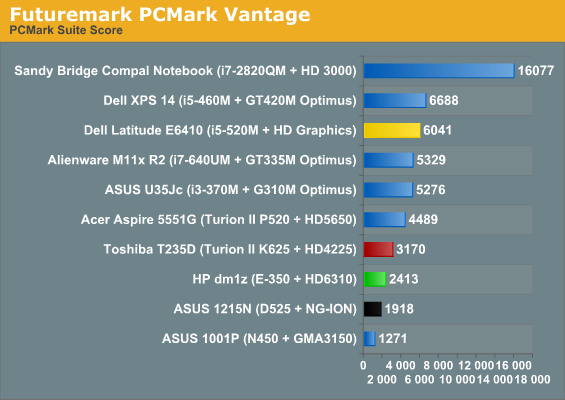
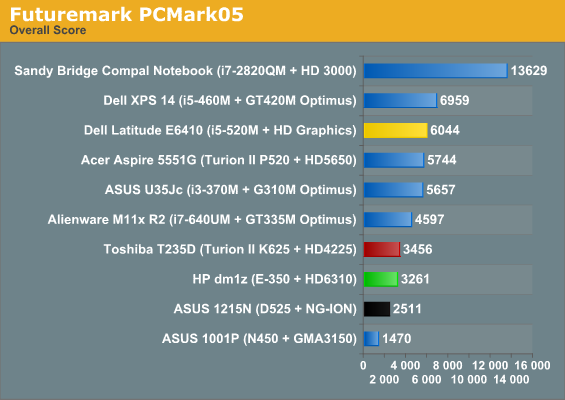
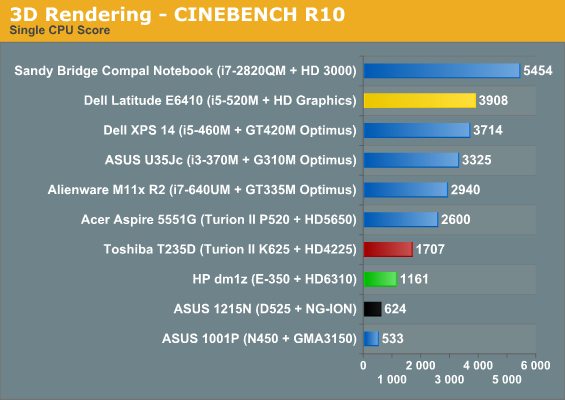
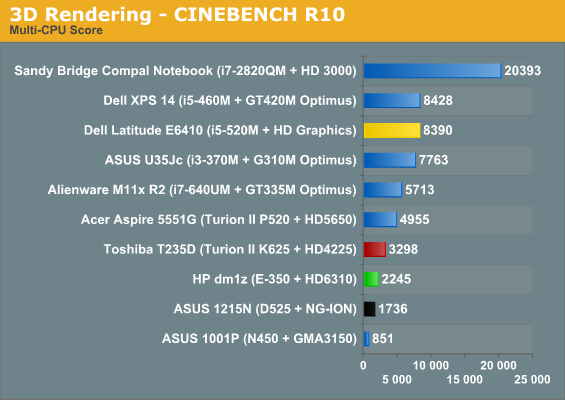
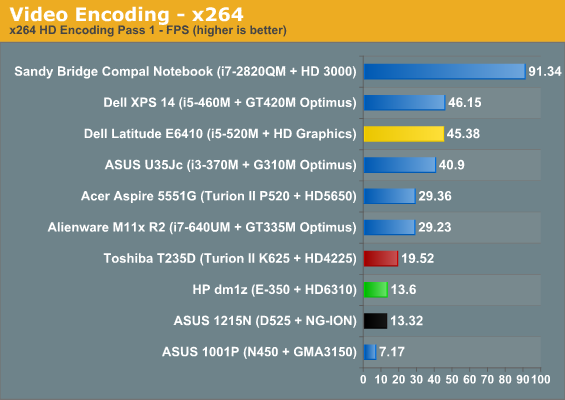
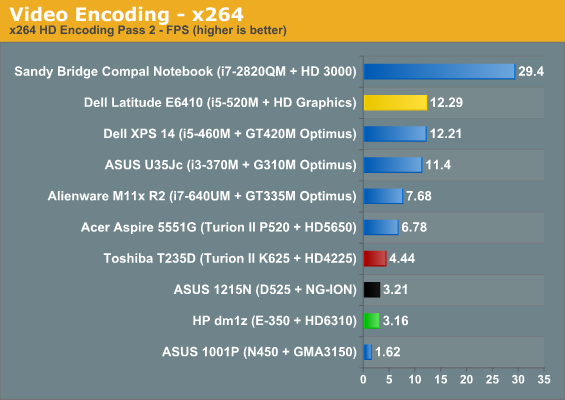
The first thing you'll notice is that while the E-350 generally cleans Atom's clock (the dual-core nettop D525 only comes out with a slight lead in the 2nd pass x264 encode), it's also generally about two-thirds as fast as the Nile platform's 1.5GHz Turion II K625. That's not too bad, but this is part of what Jarred's talking about, especially when you think about the Intel Core 2-based CULV kit that periodically kicks around the market (becoming stunningly rarefied). CULV hardware has also floated around the price point the dm1z is hitting shelves at, too, but it was fairly inconsistent. On the flipside, it does beat dual-core Atom equipped with NVIDIA's NG-ION, and this is a trend that's going to continue.
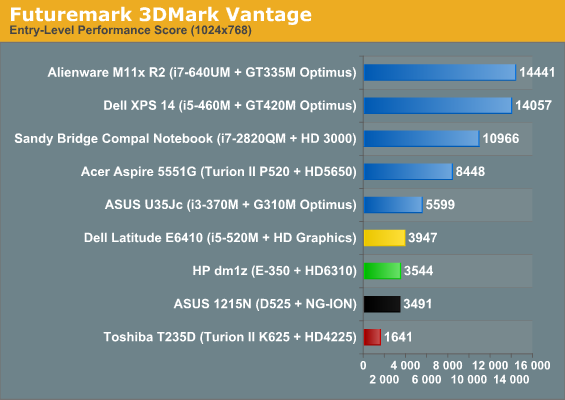
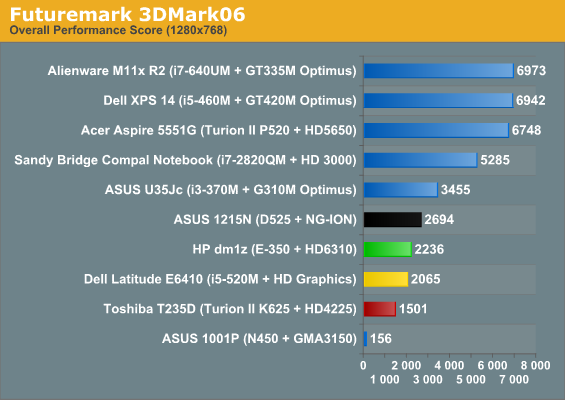
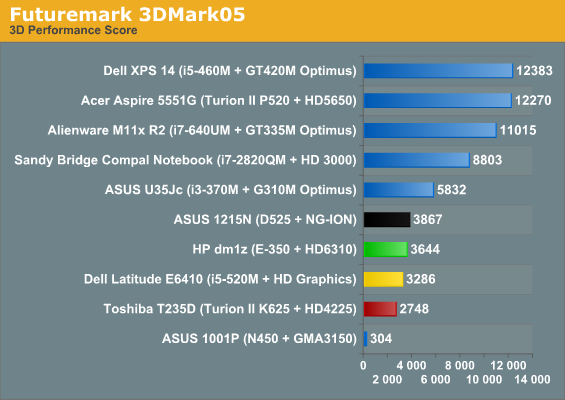
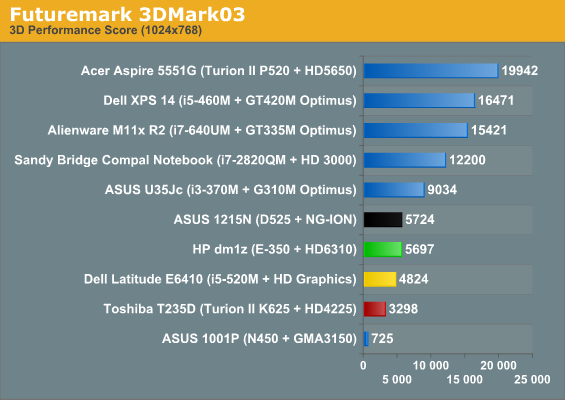
In 3DMark the E-350's integrated Radeon HD 6310 generally hangs out in the neighborhood of NG-ION, but it soundly beats Intel's last generation IGP (with better drivers and more stable performance to boot), and embarasses the Nile platform's Radeon HD 4225. That's not too surprising: in terms of raw GPU power the HD 6310 features twice the number of stream processors and a higher core clock.
If anything, the HD 6310 shows just how long in the tooth AMD's current IGP has really gotten: when it debuted as the 780G, it was a revelation, offering the best IGP performance bar none. The problem is that AMD just let it sit, offering new model numbers with no real performance increase outside of adding DirectX 10.1 support and bumping clocks slightly in some cases while serving us a warmed over Radeon HD 4550 in the form of the Radeon HD 5450 when they really should've just been integrating that hardware into their chipsets.
Ah well. With Brazos here now and Llano on the horizon, the era of AMD integrated graphics parts wearing out their welcomes should come to a close.










108 Comments
View All Comments
Shadowmaster625 - Tuesday, February 22, 2011 - link
There was a 200 post thread on slickdeals that showed how you could get this notebook for around $400. Some people were even getting it under $400. I dont know if you still can though.Wieland - Tuesday, February 22, 2011 - link
It's definitely not available anymore, but I was lucky enough to jump on while it lasted. I got one for $352.99 including taxes and shipping after cashback with no payments due for six months through BillMeLater. I finally have a replacment for my Travelmate 8006lmi.jrs77 - Tuesday, February 22, 2011 - link
Can you load a copy of Ubuntu 10.04 LTS and see if it works?I'd rather not have a bloated OS like Win7 on a netbook.
MrVeedo - Tuesday, February 22, 2011 - link
i thought i read the dm1z was shipping with ddr3 1066 memory? does the platform indeed run at 1333?xavier78 - Tuesday, February 22, 2011 - link
HP lists the webcam as VGA, not 1.3MP. Do they now offer that as an option to upgrade?Quixote One - Tuesday, February 22, 2011 - link
I agree that the new Brazos version of the dm1z is a slick little machine. The deal-breaker for me is the lack of the most current, higher-speed data-transfer interfaces -- an especially egregious omission in a netbook/"notbook"-class machine without an on-board optical drive. Other machines in this class have had either USB 3.0 or eSATA ports (and often both) for a year or more now as pretty standard features.If HP rolls out a follow-up model at around the same price point with at least one or the other (and hopefully, a less dismal screen), I'm there in a heartbeat.
darkhawkff - Tuesday, February 22, 2011 - link
I think you're seriously mistaken on many comments here. I don't see this AMD Brazos platform as being any better than what's been out for a year plus.HP Mini 311 does as well as this netbook does, and it's been out for well over 1.5 years now. How is this a step up?
Just a word of advice, look at the whole netbook scene before making an article. Even the Asus 1215N is similar in performance in most respects. There again, how is this giving people the 'netbook they've been waiting for'? It isn't. It's a side grade from AMD, if you don't like the evil powers of Intel/NVidia.
Plain and simple, stop leaning towards AMD. The only real advantage I see, is the price. It's probably a little bit cheaper than the Intel/NVidia solution, which you barely make mention of.
Overall, I see this article as a "Look what AMD did! You should buy it!", when comparable performing machines have been around for quite a while (my Mini 311 cost $700 1.5 years ago....when this was cutting edge).
Taft12 - Tuesday, February 22, 2011 - link
The last bit you said in brackets is why this is a notable machine. Netbook performance that cost $700 just 18 months ago is now $449 (or ~$400 on some slickdeals post) thanks to integrating all the discrete components that were needed on that platform (CPU/northbridge/southbridge/PCIE bus/graphics chip). Battery life also benefits greatly from this as you would expectApparently the netbook segment isn't as slow-moving as everyone thought!
darkhawkff - Tuesday, February 22, 2011 - link
I think you missed the point. We could do this 18 months ago, and still achieve the same relative performance. Yes, it cost more 18 months ago, but that's how technology works. As time progresses, prices decrease for the same performance. The idea though, was that Fusion would be a big increase in netbook performance. So, where's my increase? It's not there, and thats the point. This article made it seem like this was an increase compared to whats out there. It's not, which is my point. Another thing of note, Ion is based on the 9000 series NVidia chips, so Fusion (ie 5400 series product) is only comparable to a 4 generation old competitor? As I said, the article makes this sound as if it's a new and exciting product. It's new, but it's not exciting, and it doesn't increase performance. The only thing this has going for it, is price. If NVidia could put a chipset out for Ion, this would be irrelevant when it comes to 'netbook performance'. Plain and simple.joe4324 - Tuesday, February 22, 2011 - link
its not cheaper even, ION on a 11.6" screen was $399 16 months ago... This is coming out at the same price I thought?